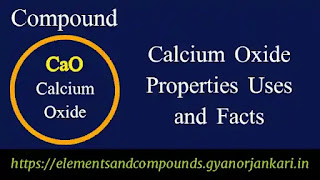Properties Uses and Facts about Calcium Oxide
What is Calcium Oxide
Calcium oxide is a compound, it is a chemical combination of calcium and
oxygen, it has the chemical formula CaO. Its molecule contains one atom of
calcium and one atom of oxygen. At room temperature, it is a crystalline,
alkaline, caustic, and white solid. Also known as quicklime, slaked lime and
burnt lime, it is an alkaline substance that has been in use since medieval
times. It is believed that slaked lime is one of the oldest chemicals known
to mankind. Calcium oxide is white or gray in color, in addition it is also
yellow or brown in the presence of impurities such as iron, magnesia,
silica, or alumina.
Properties of Calcium Oxide
- Calcium oxide often appears as hard lumps as an odorless, white or gray-white solid.
- It is a very stable compound and can withstand high temperatures.
- Its density is 3.34 grams per cubic centimeter.
- This compound crystallizes in a cubic crystal lattice.
- Calcium oxide is found in solid form at room temperature, its boiling point is 2572 °C and its boiling point is 2850 °C.
- In the presence of water it forms slaked lime. This process is called slaking of lime.
- It generates a lot of heat when it comes in contact with water, this heat is so high that it can easily ignite the surrounding flammable materials.
- Calcium oxide is basic in nature and forms salt when it comes in contact with acid.
- Calcium oxide is soluble in water.
- Calcium oxide is known to emit an intense glow when heated to temperatures above 2400 °C.
- It can cause severe irritation if it comes in contact with wet skin, eyes and mucous membranes.
Uses of Calcium Oxide
- Calcium oxide is a key material for the cement manufacturing process.
- It is used to treat drinking water.
- It is used to remove impurities from the mixture during steel production.
- Used to make pulp in the paper industry.
- In ancient times, it was used for making floors, building houses by joining bricks and for plastering walls.
- It is used to produce caustic soda.
- It is used to increase the load bearing capacity of soil.
- A lot of heat is generated when calcium oxide is mixed with water, so the process is used as a convenient portable source of heat. This method of heating is used by various companies that sell cooking kits, such as a self-heating can for quickly heating food, heating water, and cooking without open flames.
- Calcium oxide is used in the petroleum industry to trace water in fuel storage tanks. For this the water detecting paste consists of a mixture of phenolphthalein and calcium oxide. When the water in the fuel storage tank reacts with the paste, the CaO reacts with the water to produce calcium hydroxide. Phenolphthalein is changed to a bright violet-pink color by calcium hydroxide because it has a high enough pH, and this change indicates the presence of water.
- Calcium oxide is used for mining weak rocks. For this a shot hole is drilled in the rock and then inside the shot hole, a sealed cartridge of quicklime is placed and tamped. The amount of water injected into the cartridge results in the release of steam, which when combined with a high amount of residual hydrated solids can break down the rock. However, this will not work if the rock is particularly strong.
- It is also used in laboratories as a reagent for dehydration, precipitation reactions, etc.
- It is also widely used for medicinal purposes and insecticides.
Facts about Calcium Oxide
- Some things should be kept in mind while using calcium oxide. Its reaction with water is exothermic, producing a large amount of heat. Quick lime can cause severe burns, especially when it comes in contact with eyes or wet skin or when it is inhaled. Inhalation produces a number of effects, some of them being difficulty breathing, coughing or sneezing. In addition, there may also be burning sensation in the abdomen, vomiting and nausea with perforation of the nasal septum.
- It generates a lot of heat when it comes in contact with water, this heat is so high that it can easily ignite the surrounding flammable materials.
- Quicklime is heated to 4,350 °F or 2,400 °C to produce an intense glow. This type of lighting, called limelight, was widely used in theatrical productions before the invention of electric lighting.
Detailed Information on Some other Compounds
- Zinc Nitrate Properties Uses and other Details
- Aluminium Nitride Properties Uses and other Details
- Hydroiodic acid Properties Uses and other Details
- Dinitrogen Pentoxide Properties Uses and other Details
- Iodic Acid HIO3 Properties Uses and other Details
- Phosphine (PH3) Properties Uses and other information
- Ethanol Properties Uses and Other Details
- Potassium Cyanide | Properties | Uses | Other Details
- Sodium Hydroxide | Properties | Uses | Facts
- Methane Gas | Properties | Uses | Facts
- Ammonia | Properties | Uses | and Facts
- Sulfuric Acid H2SO4 | Properties | Uses | and Facts
- Nitric Acid HNO3 | Properties | Uses | and Facts
- Hydrochloric Acid HCL | Properties | Uses | and Facts
- Potassium Nitrate KNO3 | Properties | Uses | and Facts
- Hydrogen Peroxide H2O2 | Properties | Uses | and Facts
- Sodium Bicarbonate NaHCO3 | Properties | Uses | and Facts
- Aluminum Oxide Al2O3 | Properties | Uses | and Facts







No comments:
Post a Comment